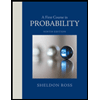
A First Course in Probability (10th Edition)
10th Edition
ISBN: 9780134753119
Author: Sheldon Ross
Publisher: PEARSON
expand_more
expand_more
format_list_bulleted
Concept explainers
Topic Video
Question
Consider a binary code with 7 bits (0 or 1) in each code word. In each code word, a bit
is a zero with
(a) How many different code words are there?
(b) How many code words have exactly three 0’s?
(c) What is the probability that a code word contains exactly three 0’s?
Expert Solution
This question has been solved!
Explore an expertly crafted, step-by-step solution for a thorough understanding of key concepts.
Step by stepSolved in 2 steps

Knowledge Booster
Learn more about
Need a deep-dive on the concept behind this application? Look no further. Learn more about this topic, probability and related others by exploring similar questions and additional content below.Similar questions
- A group consists of 5 Democrats and 8 Republicans. 7 people are selected to attend a conference.a. In how many ways can 7 people be selected from this group of 13?b. In how many ways can 7 Republicans be selected from the 8 Republicans?c. Find the probability that the selected group will consist of all Republicans.arrow_forwardTo set up a password for a computer account, the password must consist of two lowercase letters (a to z) followed by one capital letter (A to Z) followed by four digits (0,1,...,9). For the following two questions, you can leave the answers in multiplicative and fraction forms. (a) Find the total number of possible passwords. (b) Find the probability that the password contains at least one repetition in the letters or numbers. Note that the same letter in lowercase and in capital letter is considered as a repetition, for example, abA1234 is considered having a repetition in letter “a”.arrow_forwarda code is made by selecting 7 different letters, one after another, from the 26 letters in the english alphabet. wheat probability weight should be assigned to each code? a. 1/P(26,7) b. 1/C(26,7) c. 1/26^7 d. 1/7^26 e. none of these are correct f. 1/182arrow_forward
- Suppose that in a certain large population, the proportion of people that have blood type O is 0.33. If 7 people are randomly and independently selected from this population, what is the probability that no more than one has blood type O? (Give your response to at least 3 decimal places. Give only your numeric response, and not any extra characters or symbols.) Your Answer:arrow_forwardAccording to a survey, the probability that a randomly selected worker primarily drives a van to work is 0.725. The probability that a randomly selected worker primarily takes public transportation to work is 0.091. Complete parts (a) through (d). (a) What is the probability that a randomly selected worker primarily drives a van or takes public transportation to work? P(worker drives a van or takes public transportation to work) = (Type an integer or decimal rounded to three decimal places as needed.) (b) What is the probability that a randomly selected worker primarily neither drives a van nor takes public transportation to work? P(worker neither drives a van nor takes public transportation to work) (Type an integer or decimal rounded to three decimal places as needed.) (c) What is the probability that a randomly selected worker primarily does not drive a van to work? = P(worker does not drive a van to work) = (Type an integer or decimal rounded to three decimal places as needed.) (d)…arrow_forwardA jury pool has 23 people that are married and 21 people that are not married, from which 12 jurors will be selected. Assuming that each person is equally likely to be chosen and that the jury is selected at random without replacement, find the probability that the jury consists of the following. (Give answer as a fraction or a decimal out to at least 4 places. If your answer is very small use scientific notation out to 4 decimal places for example 3.3421E-6.) (a) all married people. (b) all not married people. (c) 8 married and 4 that are not married. (d) 6 married and 6 that are not married.arrow_forward
- Suppose the probability of winning a particular lottery is 1 in 14C5 •6 or If Juanita and Michelle each play the lottery on one particular evening, what is the 12,012 probability that both will select the winning numbers if they make their selections independently of each other? ..... The probability that both will select the winning numbers is approximately (Use scientific notation. Use the multiplication symbol in the math palette as needed. Round to the nearest hundredth as needed.)arrow_forwardIn a certain lottery, an urn contains balls numbered 1 to 37. From this urn, 5 balls are chosen randomly, without replacement. For a $1 bet, a player chooses one set of five numbers. To win, all five numbers must match those chosen from the urn. The order in which the balls are selected does not matter. What is the probability of winning this lottery with one ticket? The probability of winning is (Use scientific notation. Use the multiplication symbol in the math palette as needed. Round to the nearest hundredth as needed.)arrow_forwardDigits from 1 to 9 are randomly placed to form a 9-digit number. What is the probability that the number is divisible by 18?arrow_forward
- In a lottery, the top cash prize was $659 million, going to three lucky winners. Players pick five different numbers from 1 to 57 and one number from 1 to 42. A player wins a minimum award of $450 by correctly matching three numbers drawn from the white balls (1 through 57) and matching the number on the gold ball (1 through 42) What is the probability of winning the minimum award? The probability of winning the minimum award is (Type an integer or a simplified fraction.)arrow_forwardther between 25 and 54, inclusive, or at least 35. below. pability that a person chosen is at least 35, then subtract from the sum the probability that the pe that by the total number of people. he probability that a person chosen is at least 35. ide that by the total number of people. Frequency of Naturalized Persons by Age Bracket kɔuanbas (ak) oby Age (yr) Frequency 18-19 20-24 25-29 30-34 35-39 960'9 49,763 45-49 40,307 31,004 26,513 15,505 23,548 10,504 50-54 56,624 63,898 55-59 9-09 68,940 56,638 65-74 75 & over 40-44 Print Donearrow_forward
arrow_back_ios
arrow_forward_ios
Recommended textbooks for you
 A First Course in Probability (10th Edition)ProbabilityISBN:9780134753119Author:Sheldon RossPublisher:PEARSON
A First Course in Probability (10th Edition)ProbabilityISBN:9780134753119Author:Sheldon RossPublisher:PEARSON

A First Course in Probability (10th Edition)
Probability
ISBN:9780134753119
Author:Sheldon Ross
Publisher:PEARSON
